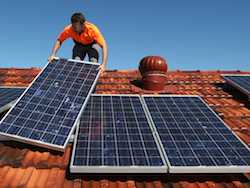According to the latest “Energy Infrastructure Update” report from the Federal Energy Regulatory Commission’s Office of Energy Projects, solar, wind, biomass, geothermal, and hydropower provided 55.7% (1,965 MW of the 3,529 MW total installed) of new installed U.S. electrical generating capacity during the first half of 2014.
- Solar provided 32.1% (1,131 MW)
- Wind provided 19.8% (699 MW)
- Biomass provided 2.5% (87 MW)
- Geothermal provided 0.9% (32 MW)
- Hydropower provided 0.5% (16 MW)
- Most of the balance (1,555 MW – 44.1%) of the new generating capacity was provided by natural gas while no new coal or nuclear power capacity was reported
 According to the SUN DAY Campaign, the dominant role being played by renewables in providing new electrical generating capacity in 2014 is continuing a trend now several years in the making. Over the past 30 months (i.e., since January 1, 2012), renewable energy sources have accounted for almost half (48.0%) or 22,774 MW of the 47,446 MW of new electrical generating capacity.
According to the SUN DAY Campaign, the dominant role being played by renewables in providing new electrical generating capacity in 2014 is continuing a trend now several years in the making. Over the past 30 months (i.e., since January 1, 2012), renewable energy sources have accounted for almost half (48.0%) or 22,774 MW of the 47,446 MW of new electrical generating capacity.
If calendar year 2011 is also factored in, then renewables have accounted for approximately 45% of all new electrical generating capacity over the past 3 1/2 years. In fact, since January 1, 2011 renewables have provided more new electrical generating capacity than natural gas (31,345 MW vs. 29,176 MW) and nearly four times that from coal (8,235 MW)
Renewable energy sources now account for 16.28% of total installed U.S. operating generating capacity: water – 8.57%, wind – 5.26%, biomass – 1.37%, solar – 0.75%, and geothermal steam – 0.33%. This is up from 14.76% two years earlier (i.e., June 30, 2012) and is now more than nuclear (9.24%) and oil (4.03%) combined.
“A new report from the U.S. Energy Information Administration (EIA) is projecting that renewable energy sources will account for only 24% of new capacity additions between now and 2040,” Ken Bossong, Executive Director of the SUN DAY Campaign, noted. “However, the latest FERC data coupled with that published during the past several years indicate that EIA’s numbers are once again low-balling the likely share – and probably dominant share – of renewables in the nation’s future energy mix.”

